How the Space Shuttles were given better names thanks to Star Trek
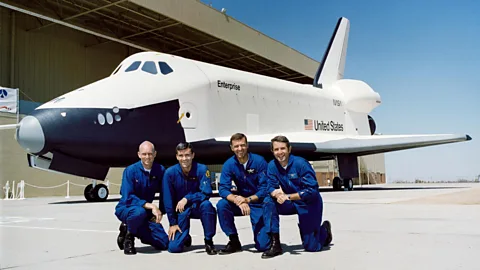 Nasa
NasaThe first Space Shuttle was originally going to be named Constitution. US President Gerald Ford agreed to rename it Enterprise – here's how Star Trek fans persuaded him.
It's 17 September 1976. The world's press has gathered in Palmdale, California, for the revealing of Nasa's first Space Shuttle vehicle: The Enterprise. But it wasn't always supposed to have that name.
It was a huge day for Nasa and for the US administration, as they began a new adventure in space travel. After the Moon landings, the Space Shuttle would be Nasa's project to make spaceflight routine, affordable and accessible for the future.
In the audience were presidential aides, Nasa officials, astronauts and some very special guests. Many of the cast and crew members of TV science fiction series Star Trek also came along to watch the vehicle be unveiled.
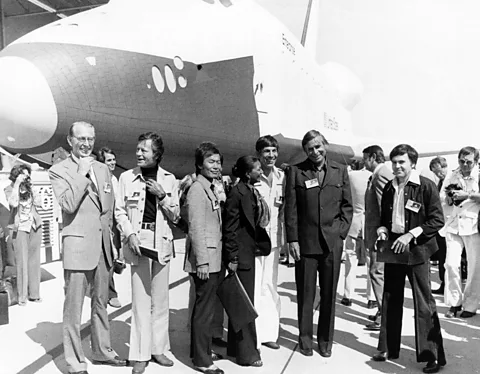 Getty Images
Getty ImagesIt was also quite the day for the show's fans. The US president and Nasa agreed to dedicate and name the first Space Shuttle after the flagship of Star Trek’s fleet, the Star Ship Enterprise.
"Nasa has received hundreds of thousands of letters from the space-orientated Star Trek group, asking that the name be given to the craft," said government aide William Gorog, in a now declassified memo to the then President, Gerald Ford.
13 Minutes Presents: The Space Shuttle
In a new season of the award-winning podcast 13 Minutes to the Moon, Maggie Aderin-Pocock tells the story of triumph and tragedy behind the space shuttle. Listen to the new series of 13 Minutes Presents: The Space Shuttle here. If you are in the UK, you can listen to it on BBC Sounds here.
Fans bombarded Nasa and the White House with letters about why the ship should be renamed. And it was not the first time Star Trek fans had run a campaign like this, either.
The mastermind behind the campaign was among those watching the unveiling at Palmdale. Her name is Betty Jo Trimble, otherwise known to Star Trek fans as Bjo Trimble. She has become something of an icon in the science fiction world.
Bjo became famous for her fashion shows at the World Science Fiction Convention, which was an early form of Comicon. Her fashion shows would give fans a glimpse of all kinds of outfits from the sci-fi world. But, one day, Gene Roddenberry, the creator of Star Trek, got in touch with her. He wanted to use the fashion shows to promote some early Star Trek costumes.
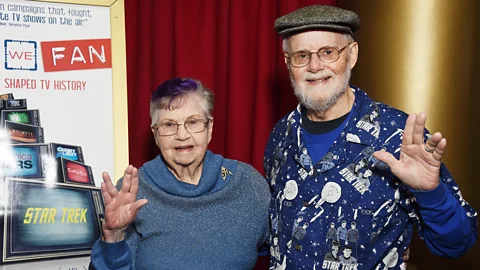 Getty Images
Getty ImagesTrimble became a close friend of the show. She was invited on to set to meet the actors. She got to know Rodenberry personally. She ran her own fanzine. They would even become a crew member, when they appeared in an unnamed role in the Star Trek: The Motion Picture in 1979.
But Bjo is most famous for running the successful Save Star Trek campaign, with her husband John Trimble, which stopped NBC from cancelling the show after its first two seasons. The campaign has become one of the most famous in TV history.
"Star Trek fans could be very persuasive," admitted Leonard Nimoy, who played Spock in the series. (He also attended the Enterprise ceremony.)
Building the space shuttle
The Space Shuttle was a challenge that had never before been undertaken by a space programme. The idea was to create a vehicle that could leave the Earth like a rocket but then land after its mission was completed like a plane.
The challenge was famously laid down to Nasa's engineers at a meeting on April Fool's Day 1969 where Max Faget, an eccentric mechanical engineer who could always be found wearing his famous bowtie, strode into the room, pulled a balsa wood model of a "funny looking" plane from a bag and flew it across the room. Faget was the designer behind the Mercury spacecraft, and later the Apollo and Gemini aircraft for Nasa, and would play a vital part in the design of the new shuttle as engineers tried to figure out how to build the vehicle within Nasa's budget. (Hear more about the dramatic story of this pioneering spacecraft in 13 Minutes Presents: The Space Shuttle.)
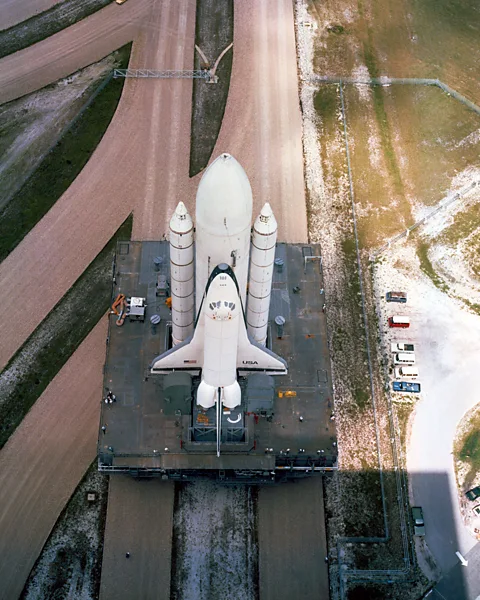 Nasa
NasaPalmdale in California was the centre of the aeronautics industry. One of the biggest companies there was Rockwell International, which had built aircraft like the successful B-1 bomber, which is still in service today. Rockwell were offered the contract to the build this prototype.
In 1974, construction began and two years later, the Shuttle was finally ready to be unveiled.
Changing the name
The prototype was originally planned to be called The Constitution, to mark the centenary of the foundational document of the United States. But Star Trek fans had other ideas.
"A couple of other fans started this project, but for some reason, they could not finish it, and asked us to take it over," Bjo Trimble told the official Star Trek website in an interview in 2023. "We thought it was a good idea to make the public really aware of the space programme by using a popular name for the first shuttle."
The Trimbles, among a few others, set up another letter-writing campaign to change the name, drawing on the same techniques they had used during the Save Star Trek campaign. There were no home computers at time, so the couple hit the phones, connecting conventions, newsletters and Star Trek communities all over the world through typewriter and telephone
Eventually their letters began to work and found their way into a memo to the President. In the declassified letter Gorog suggested to President Ford that the idea might help the space programme.
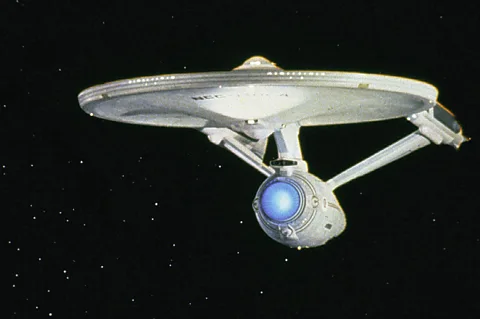 Paramount Television/Alamy
Paramount Television/AlamyAfter all, Nasa was launching a new ship and a new idea to the American public. It needed their attention.
Gorog summarised in the memo:
- This group comprises millions of individuals who are deeply interested in our space programme
- The name "Enterprise" is tied in with the system on which the Nation's economic structure is built.
- Use of the name would provide a substantial human interest appeal to the rollout ceremonies scheduled for this month in California, where the aeronautical industry is of vital importance.
Many agreed. James Fletcher, Nasa's chief administrator was also open to the idea. Jim Cannon, a political advisor to President Ford, agreed it seemed an "excellent name", that it would "personally gratify" one of the most dedicated constituencies in the country.
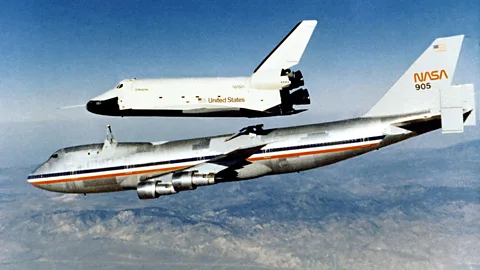 Getty Images
Getty ImagesAnd there was naval history to the name too. During World War Two, Enterprise was an aircraft carrier that served in the Pacific while another ship with the name helped fight pirates in 1803 in the days of the American republic.
Eventually, the five Space Shuttles that followed all bore the names of famous ships of exploration that had traversed Earth's oceans: Columbia, Challenger, Discovery, Atlantis and Endeavour.
President Ford responded positively to the pressure, approving a decision memo recommending the name change on 3 September 1976. A few days after the memo, the President met with Fletcher to confirm that a name change would be suitable.
It offered both a public relations win for the presidential office, Nasa and Star Trek fans.
The rollout
Back to the big unveiling day in Palmdale, the nose of Enterprise appeared from the corner of a giant aircraft hangar. It was flanked either side by white-suited technicians. It was brilliant white, with a black underside, stubby wings and a high tail fin.
As the vehicle's wheels rolled onto the tarmac, the United States Air Force band had a surprise for the gathered guests. They broke out into the Star Trek theme to massive cheers from the audience.
The vehicle would be used for the early aerial and landing tests of the Shuttle in the years that followed. These gave the astronauts and pilots who would later fly the Space Shuttles on their missions into orbit vital experience of what the vehicle could do.
Eventually, on 12 April 1981, Nasa flew STS-1, the first flight of the Space Shuttle programme. The vehicle they used, Columbia, was redesigned from the original Enterprise prototype. But the legacy of the original vehicle and the public relations campaign stuck.
Actress Nichelle Nichols, who portrayed Lieutenant Uhura on the TV show, was hired by Nasa to help them recruit women and members of minority groups to the astronaut programme in the 1970s.
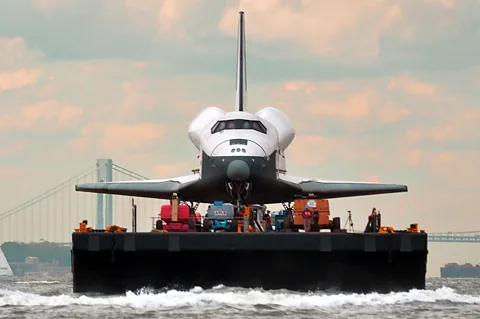 Getty Images
Getty ImagesOther sci-fi fans wanted in on the action too. After Space Shuttle Enterprise was renamed, a flyer appeared in the Star Wars newsletter Falcon. Star Wars fans wanted their place in space history too. Using a similar letter writing campaign to Star Trek's, they started their own campaign. Sadly, they were unsuccessful in naming the second shuttle the Millenium Falcon, but the legacy of the links between sci-fi and the US space agency are still strong.
Over the years many astronauts have used for Star Trek motifs on their mission badges and in group portraits. Others have spoken about how the show inspired them in the first place while many of the actors have developed strong relationships with Nasa.
In 2012, some of the same Star Trek stars who were there at that initial rollout of the space shuttle Enterprise watched as the craft made its final journey, landing at John F Kennedy Airport in New York on its way to its current home at the Intrepid Sea, Air and Science Museum.
It was a fitting tribute to a spacecraft that, to use words from the opening sequence of Start Trek, had enabled humans to boldly go where no-one had gone before.
--
If you liked this story, sign up for The Essential List newsletter – a handpicked selection of features, videos and can't-miss news, delivered to your inbox twice a week.
